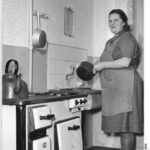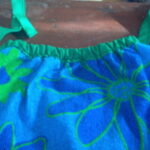It has been the family joke for years that cooking is not exactly my forte. If it doesn’t come in a box or from a restaurant, I am usually not interested. Fortunately, there are idiosyncrasies to every human being. Mine is that I enjoy going to Mill City Museum in Minneapolis, a place dedicated to the flour industry. Flour, as you know, is a major ingredient in cooking. And my loved ones thought they had me pegged! Allow me to put on my apron and tell you more about this interesting place.
In addition to the flour industry, visitors to the Mill City Museum also learn about the histories of the riverfront and of the city of Minneapolis. From 1880 to approximately 1930, Minneapolis was known as the “Flour Milling Capital of the World” or just by its nickname of “Mill City.” In 1870, Minneapolis was the size of a smaller suburb today, around 13,000 people. Within 20 years, due in part to the growth of the milling industry, it had increased more than tenfold to 165,000. Milling remained as the backbone of the city’s economy through the end of World War 1, when it began a slow decline. Eventually, the industry moved out of Minneapolis and the Washburn A Mill shut down in 1965.
History of the Washburn A Mill
The Minnesota Historical Society obtained the ruins of the Washburn A Mill in 2003 and created what is now the Mill City Museum. Two fires, one in 1991 and the other in 1878, play a major role in the history of this building. The 1878 fire was caused by a flour dust explosion that killed 18 people and destroyed much of the riverfront business district area. The explosion could be heard as far away as Summit Avenue in St. Paul and caused cracks in some windows there. The building was a total loss and was rebuilt in 1880, this time with better equipment to capture and collect the highly explosive flour dust.
The cause of the 1991 fire remains undetermined, though it is speculated that it was caused by homeless people using the vacant mill to escape a frigid Minnesota winter night. Squatters, a rather unfortunate name for the homeless, were known to occupy this building on a regular basis. The fire gutted much of the Washburn A Mill building, with only its outer wall left standing. It remained in this condition until obtained by the Minnesota Historical Society 12 years later, and remains that way today.
Riverfront History
The Mississippi riverfront in Minneapolis is the oldest part of the city. People originally settled in the area because the river provided energy and transportation so the city could grow. Minneapolis had its origins around St. Anthony Falls, which was the only waterfall in the area on the Mississippi River.
Beginning in the 1850’s, water from St. Anthony Falls was used as a source of power for the lumber and milling industries. By the 1880’s, Minneapolis was the world leader in flour production and remained so for the next 50 years. As changes in transportation and industry continued, the area moved away from lumber and flour industries and businesses left the area. Today, the St. Anthony Falls area has been revitalized and visitors enjoy a wide array of activities, from walking and biking the trails to dinner and entertainment at the new businesses that have sprang up.
Visiting Mill City Museum
The Flour Tower
The Flour Tower tour is a unique experience, and the general consensus among my family of four is that it’s also our favorite attraction. You enter an elevator and take a seat on what resembles an amusement park ride. After everyone from that hour’s tour have crowded onto the three long benches, the elevator starts moving and the Minnesota Historical Society employee begins his or her narration on the history of Washburn A Mill. There are eight floors in which to see working life at the mill as it would have been up through 1965. Recorded voices of actual mill employees add to the feeling that you are right there with them. There is the production area, where you see flour being put into bags bearing the Gold Medal label and an office, complete with manual typewriter, stenograph machine and an ashtray with a half-smoked cigarette. (Thank goodness some things do change!)
After seeing eight floors from the elevator, you are allowed out onto the observation deck. This provides a spectacular view of the city, the Mississippi River waterfront, and the ruins of the 1991 fire. Minneapolis’ often-photographed Stone Arch Bridge is directly across from the mill.
The Baking Lab
If you don’t immediately see the Baking Lab, your nose will lead you there. Wonderful aromas of cookies or cinnamon baked bread waft pleasantly throughout the main floor. Inside, you will have the opportunity to try samples and see the various types of grain and flour that the mill used to produce. Glassed-in cases show some of the icons of baking from days gone by, such as the Easy Bake Oven. A bookcase holds just about any type of cookbook you can imagine, and this is where Yours Truly was photographed holding The Joy of Cooking.
The Water Lab
If you have kids who are hands-on learners like I do, they will really enjoy experimenting in the Water Lab. One such opportunity allows young and old alike to place their hand under a tube of rushing water in order to feel the water pressure that at times reached over 2000 pounds. They can also build a dam or a bridge and float logs downstream to a sawmill, all on a toy scale, of course.
Wrapping it Up
The old saying there’s something for everyone really does apply here. Like explosions? Check out the demonstration of a model mill recreating the 1878 flour dust blast. Want to see a movie? Be sure to catch Minneapolis in 19 Minutes Flat by humorist Kevin Kling. Like to just read about history at your own pace? There are dozens of exhibits where you can do just that.




